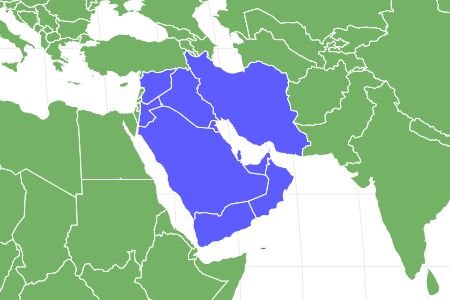Persian
Felis catus
The Persian cat is a famous breed with an instantly recognizable appearance.
Advertisement
Persian Scientific Classification
- Kingdom
- Animalia
- Phylum
- Chordata
- Class
- Mammalia
- Order
- Carnivora
- Family
- Felidae
- Genus
- Felis
- Scientific Name
- Felis catus
Read our Complete Guide to Classification of Animals.
Persian Conservation Status
Persian Facts
- Fun Fact
- The Persian cat is a famous breed with an instantly recognizable appearance.
- Distinctive Feature
- A flat, pushed-in face
- Other Name(s)
- Persian longhair
- Temperament
- Intelligent, loving and affectionate
- Diet
- Omnivore
- Average Litter Size
- 4
- Common Name
- Persian
- Slogan
- Thought to have originated in the Middle East!
- Group
- Longhair
View all of the Persian images!
The Persian cat is a famous breed with an instantly recognizable appearance. Persians have sweet faces and elegant fur coats in various delicate color patterns. If you’re looking for a reserved cat that will add a touch of class to your home, the Persian is an excellent choice.
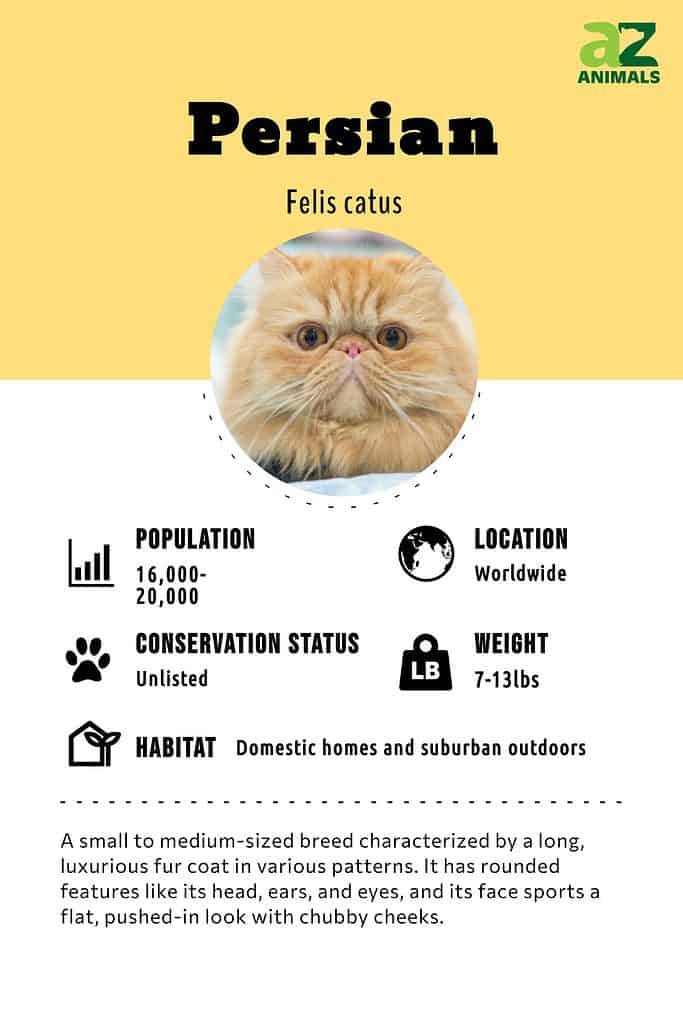
Breed History
The true origins of the Persian cat are somewhat of a mystery. The beginning of their history as we know was in the early 1600s when Persian cats first set paws on European soil as exports from Khorasan, Persia to the Italian Peninsula via Pietro della Valle. Other Persians came to France from Ottoman Turkey through Ncolas-Claude Fabri de Peiresc. Interestingly, modern Persian cats do not carry the genes of ancient Middle Eastern cats, rather, they are ancestors of European breeds.
See all of our expert product reviews.
It is from this latter group (that came to France) that Persian cats entered Great Britain, where their popularity truly took off. In fact, Queen Victoria is known to have owned multiple Persians, helping to develop their reputation as stately, sophisticated pets. The world’s first organized cat show, held in 1871 at the famed Crystal Palace in London, featured Persian cats, and one Persian kitten took the “Best in Show” title. Persians are also among the first pedigreed cat breeds. In 1875, they came to the United States, and in 1906 the Cat Fanciers’ Association was founded and recognized the Persian as one of its first registrants.
Traits: What to Know Before You Buy
Most breeders will give you a detailed explanation of how to take care of your new pet. However, before you buy, there are a few traits that you need to consider.
- These cats are known for having long coats of fur that require a lot of maintenance. Brush your cat every day; it’s a wonderful bonding exercise and will keep your cat looking pristine and elegant.
- Because the Persian breed is so highly sought after, many of these cats are bred for appearance and may develop serious health issues. Be ready to take your Persian to the vet often to improve their lifespan.
- These cats are known to be finicky eaters and may reject low-quality cat food. If your cat isn’t eating, try finding a different brand with a focus on high protein and natural ingredients.
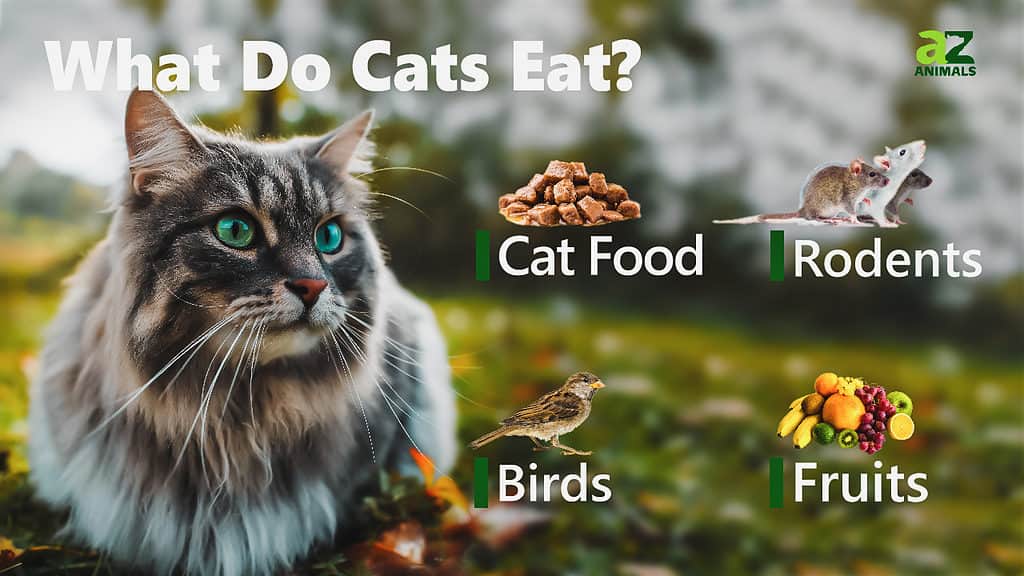
Personality
These sweet, affectionate, and laid-back cats enjoy lounging around the house and napping in beams of sunshine. These cats are not particularly vocal or needy, although they do have a picky personality and like to have their food delivered on schedule.
One of the things you’ll notice about your cat is that they don’t do well with changes to their environment. They love their primary owners, but they can take quite a while to warm up to strangers. They also don’t like loud noises, which makes them a bad match for families with small children. This personality trait often keeps Persians from getting adopted out of animal rescues, where they are under too much stress to show off their loving nature.
However, if you’re capable of providing a quiet and elegant environment for your cat, you’ll find that they make excellent company and are a soothing presence in any lifestyle. Persians love habits and will jump up on the sofa for their daily brushing at the same time as they did the day before. They also enjoy good meals and will love to try all of the best cat foods on the market.
Health and Entertainment for your Persian
See all of our expert product reviews.

©iStock.com/pat138241
Size and Weight
These cats are usually small to medium-sized and can weigh anywhere from 7 to 13 pounds. These cats stand at around 10-15 inches tall, but their long and fluffy fur often makes them look larger than they actually are.
Because the Persian breed is highly sought after and carefully monitored, you can almost always expect your purebred cat to conform to standard height and weight. Neutering this breed doesn’t usually change its size and is often very necessary to help your Persian maintain an even demeanor.

©iStock.com/slowmotiongli
Price
These cats are among the most expensive purebred cats on the market. No matter which breeder you buy from, you can expect your new kitten to cost anywhere from $1,300 to the high end of $3,000. Females often cost significantly more than males, and new kittens are typically more expensive than full-grown adults.
Because solid white Persians are so highly coveted, you can expect this color pattern to be the most expensive. Blue eyes are rarer and more expensive than copper eyes, and unique color patterns may greatly alter the cost. If you’re looking to find a Persian at a lower price, consider adopting a kitten with a cosmetic “defect” that might disqualify them from a cat show.
In addition to the price you pay at the breeder, you should also expect your cat to incur regular vet costs. Take your cat to the vet at least once a season to make sure they aren’t developing a health condition that could reduce their lifespan.

Persian cats are among the most expensive in the pure breed market, fetching prices that vary from $1300 to $3000.
©iStock.com/Olivia7
Kittens
The kittens are small, fluffy, playful, and incredibly adorable. This breed is known for being rather shy and reserved, but the kittens are generally more adventurous than full-grown adults.
These cats are not usually fully grown until they are around two years of age. Once they reach their full size, your cat should weigh between 7 to 13 pounds, with females tending to weigh one or two pounds less than their male counterparts.
The kittens are sweet and typically do well with older children. These cats love to lounge on the couch and enjoy gentle petting; however, they will often be uninterested in more than a mild amount of playtime.
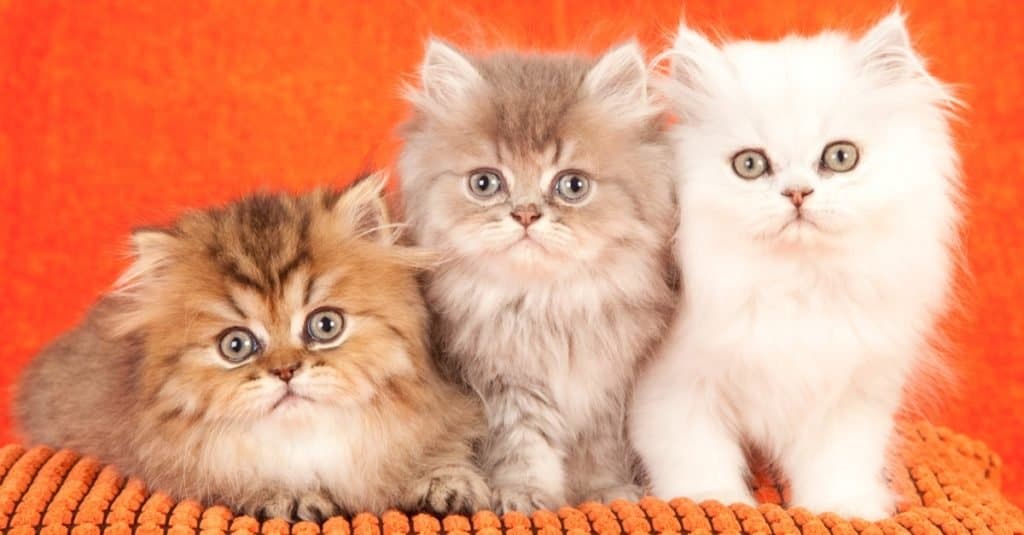
©Linn Currie/Shutterstock.com
Lifespan
Most Persians have a lifespan between 10 to 17 years, with an average lifespan of 13.5 years. This is a relatively low lifespan, especially for a purebred cat.
As much as their owners love them, studies have shown that these cats are significantly more susceptible to health issues and diseases than other breeds. Nearly two-thirds of adult cats suffer from at least one health condition, including dental diseases, eye infections, overgrown nails, and even coat disorders. These issues result in mild to extreme discomfort for the cat; however, Persian mortality is generally caused by either kidney diseases or cancer.
The generally low health of the Persian breed can likely be attributed to the fact that breeders have been selecting for coat color and the popular squished doll face that has come to distinguish the breed in recent years. As an owner, you can improve the state of the market by only purchasing from breeders that are more concerned with their cats’ health and well-being than producing a specific appearance.

©iStock.com/infinityyy
Breed vs. Mixed
Persians are incredibly popular, so it’s not uncommon to find mixed-breed cats that display Persian traits. If you want to guarantee that you have a purebred Persian, you should purchase your kitten directly from a breeder instead of from an animal rescue. Otherwise, there are a few traits that you can use to identify whether your Persian cat is purebred or mixed.
First, take note of your Persian eye colors. Most Persians have copper eyes, although a few divisions also allow for either blue or hazel eyes when combined with specific color patterns. The Cat Fancier’s Association offers details on which eye colors are viable for each division.
Next, it’s worth noting that mixed-breed Persians rarely have full-length hair, a thick tail, and doll face that are noticeable in purebreds. If your cat has shorter hair or a longer muzzle, you can be fairly certain that they are not purebred. Many animal rescues will simply mark these cats as Persians; unless you’re planning on taking them to a show, they’re still incredibly lovely and adoptable pets.

©iStock.com/Alper Akca
Types of Persian Cats and Colors
Because Persian cats are so popular, they have been bred to exhibit a wide number of different colors and patterns. This highly varied breed has been organized into seven divisions.
Solid Persians
As the name implies, the solid division consists of Persian cats with single-color coats. You can find solid Persians in white, blue, black, cream, chocolate, and lavender. All of these colors have copper-colored eyes – with the exception of the white Persian, which can also display eyes in a beautiful sapphire blue.
Tabby Persians
Tabby patterns are popular on many different cat breeds, but they look exceptionally striking on the long-furred Persian. You can find tabby Persians in classic, patched, and mackerel patterns, all with easily distinguishable markings. Available colors include red, blue, silver, cream, and cameo.
Many cat fanciers have noticed that tabby Persians are more playful and extroverted than other members of this breed. With fun patterns and social personalities, tabby Persians are a great choice as family pets.
Himalayan Persians
The Himalayan Persian is an incredibly popular variant that was created by combining classic Persians with the media-famous Siamese. The result is a cream or fawn-colored cat with soft facial and point markings in a wide variety of colors such as chocolate, lilac, blue, red, seal, and an extreme number of beautiful combinations thereof.
Because the Himalayan Persian is technically a crossbreed, it took some time for these cats to be accepted by the Cat Fanciers Association. To be qualified, a Himalayan must have sapphire blue eyes, and the point colors must only be displayed on the face, tail tips, and feet.
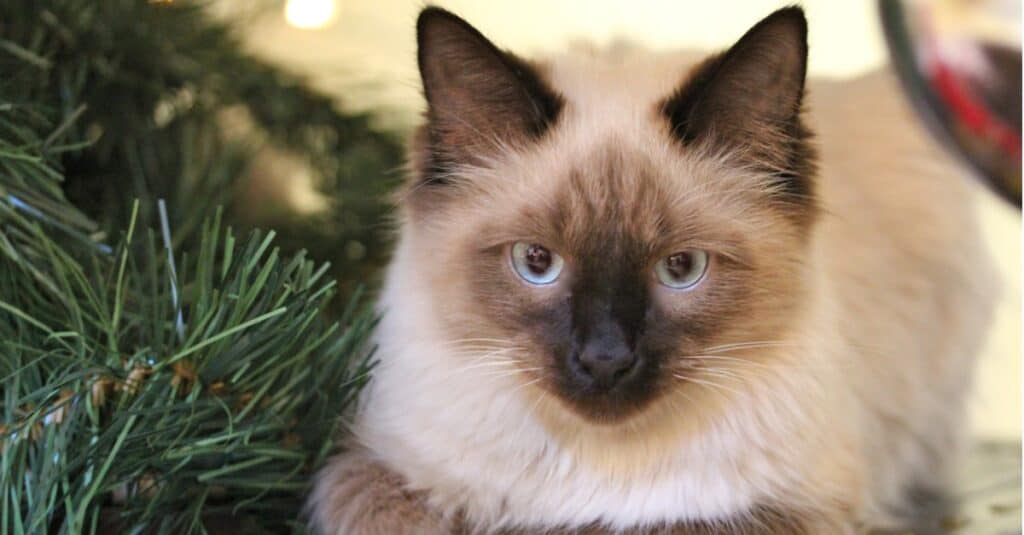
©iStock.com/Celesty
Silver and Golden Persians
With main fur colors of either moonlight silver or sunshine gold cream, the Persians in this division also display either a sparkling chinchilla pattern or a delicately shaded mantle. The chinchilla pattern is marked by light black tips across otherwise immaculate fur. Meanwhile, the shaded mantle is slightly darker and is draped across the cat’s body like a cloak. Both silver and golden Persians are capable of having either green or blue-green eyes in both chinchillas and shaded varieties.
Smoke and Shaded Persians
Shaded and smoke Persians usually have a strong undercoat that transitions into a different overcoat or tip color. The various patterns include shades of cream, black, blue, red, orange, cameo, and tortoiseshell. Breeders work carefully to create exotic effects that are only visible under the correct lighting. Persians in this division almost always have warm copper eyes.
Parti-Color Persians
The parti-color division of Persians contains four carefully bred color patterns that are instantly recognizable. There is little room for variation among the stunning tortoiseshell, chocolate tortoiseshell, blue-cream, and lilac-cream parti-colors. All of these cats feature a strong base color with beautiful patches of a secondary color that add interest and variety to the breed’s appearance. Copper eyes peek out from the beautiful doll faces of all four of these varieties.
Bi-Color Persians
This Persian division includes calicos, van patterns, and classic bi-colors. Calicos and van patterns both have white coats with splashes of color either on the extremities or across the body. Possible patch colors include orange, black, blue, chocolate, and many other shades. Meanwhile, bi-colors have coats in any of the classic Persian colors with white on the feet and chest. Most cats in the bi-color division have copper eyes, although a few breeds may also display green irises.
View all 192 animals that start with PPersian FAQs (Frequently Asked Questions)
Are Persians herbivores, carnivores, or omnivores?
Persians are Omnivores, meaning they eat both plants and other animals.
What Kingdom do Persians belong to?
Persians belong to the Kingdom Animalia.
What class do Persians belong to?
Persians belong to the class Mammalia.
What phylum to Persians belong to?
Persians belong to the phylum Chordata.
What family do Persians belong to?
Persians belong to the family Felidae.
What order do Persians belong to?
Persians belong to the order Carnivora.
What genus do Persians belong to?
Persians belong to the genus Felis.
What type of covering do Persians have?
Persians are covered in Hair.
How many babies do Persians have?
The average number of babies a Persian has is 4.
What is an interesting fact about Persians?
Persians are thought to have originated in the Middle East!
What is the scientific name for the Persian?
The scientific name for the Persian is Felis Catus.
Thank you for reading! Have some feedback for us? Contact the AZ Animals editorial team.
Sources
- Cat Fanciers Association, Available here: https://cfa.org/persian/
- Petfinder, Available here: https://www.petfinder.com/cat-breeds/persian/
- FAQ Cats, Available here: https://faqcats.com/why-are-persian-cats-so-expensive/
- RVC, Available here: https://www.rvc.ac.uk/vetcompass/news/persian-cats-at-high-risk-of-health-problems-study-shows
- Purr Craze, Available here: https://purrcraze.com/when-do-persian-cats-stop-growing

